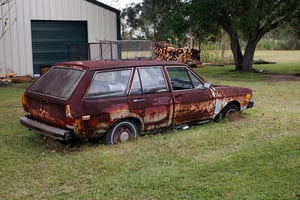 Cars depreciate in value quickly. Your car may have been your pride and joy when you first drove it off of the dealership lot. However, after many miles of wear and tear, you may feel differently. It is not uncommon for people to find themselves in a position in which their vehicle is worth much less than what they still owe on their car loan. This is not surprising when you consider the amount of interest the car loan lenders make you pay (and don’t get me started on all those extra fees the dealerships like to throw in). However, there is a solution to that expensive eyesore taking up space in your driveway. You guessed it! You can file a personal bankruptcy case.
Cars depreciate in value quickly. Your car may have been your pride and joy when you first drove it off of the dealership lot. However, after many miles of wear and tear, you may feel differently. It is not uncommon for people to find themselves in a position in which their vehicle is worth much less than what they still owe on their car loan. This is not surprising when you consider the amount of interest the car loan lenders make you pay (and don’t get me started on all those extra fees the dealerships like to throw in). However, there is a solution to that expensive eyesore taking up space in your driveway. You guessed it! You can file a personal bankruptcy case.
Bankruptcy is an awesome tool that enables people who are unable to keep up with their payments on their debts wipe those debts out and get a fresh start. Chapter 13 bankruptcies are 3 to 5 year repayment plans designed for those who earn too much money to qualify for a chapter 7 bankruptcy case and for people who want to keep extra property that would otherwise be nonexempt (unprotected from being taken to pay creditors) in a chapter 7 case. Chapter 7 bankruptcy cases are designed for lower income individuals who wish to quickly get rid of debt and do not have a lot of nonexempt property that they need to keep. The beauty of filing a personal bankruptcy case is that, regardless of whether a person files a chapter 7 or chapter 13 case, that person (known as a “debtor” after their case is filed) has the option of keeping their car, or simply surrendering it over to the car lender and completely walking away from the debt!
Bankruptcy gets rid of debts but not liens. For this reason, a car lender with a valid lien against the vehicle has the right to continue to be paid on the car loan even after a person files for bankruptcy. Ultimately, if a person stops paying for the vehicle, the car lender will repossess the car. From the very day that a person files a chapter 7 or 13 bankruptcy case, they are protected from any collection action that may be taken by that person’s creditors during their bankruptcy case. This protection from creditors is known as the automatic stay and also prevents car lenders from being able to repossess the vehicle during the bankruptcy without permission from the bankruptcy court. If a person is delinquent on vehicle payments during the bankruptcy, the car lender can file a motion for relief, in which the car lender requests that the court “lift the automatic stay” and proceed with the repossession even during the person’s bankruptcy case. If the person is really behind on payments the bankruptcy court will likely grant the motion and allow the repossession.
The good news though is that a person who either voluntarily surrenders their car (chooses to give the car back to the car lender), or has their car involuntarily repossessed for failing to make loan payments, is never liable for the debt on the loan again! The lender can resell the car to pay towards the debt but cannot come back after the person again to recoup their loss. So, if the lender sells the car for 4k, and the debtor owed 8k, the lender could not, for example, sue the debtor for the 4k (aka the “deficiency balance”) still owing on the loan.
Therefore, bankruptcy puts the debtor in the driver’s seat (pun obviously intended)! The debtor has the power to continue making their car payments and keep the car, or just walk away from the debt and let the lender take it back. Even better, the debtor has the luxury of keeping the vehicle for a long time after they file their case, even after their discharge, so long as payments continue to be made, and can simply choose to walk away at any time when it makes financial sense to do so, such as when the cost of repairs become too expensive. Again, to reiterate, the bankruptcy discharge wipes out the debtor’s liability on the vehicle loan so, at worst, the debtor loses the vehicle but with no debt remaining!
It is worth noting that, in chapter 7 cases, the creditor may ask that the debtor sign a reaffirmation agreement. By signing a reaffirmation agreement, the debtor essentially renews their agreement to continue paying on the loan despite the bankruptcy. Once the signed agreement is approved by the bankruptcy court, the debtor is allowed to keep the car so long as they remain current on their loan payments. The one benefit of signing a reaffirmation agreement is that it guarantees that the lender will not repossess the vehicle so long as the debtor makes their payments. The 2005 change to the bankruptcy code allows lender to repossess the debtor’s vehicle after their case is done and the automatic stay is lifted, even if they are not behind on payments, if they do not sign a reaffirmation agreement. It is usually not advisable for the debtor to actually sign a reaffirmation agreement though. Why? In the vast majority of cases, the lender will not take the time and effort to repossess the vehicle so long as payments are made on time. As stated above, so long as a reaffirmation agreement has not been signed, the debtor the advantage of keeping the car as long as they want and allows them to surrender it when they want. When considering one’s options and weighing the risks versus benefits of signing a reaffirmation agreement, it is always a smart idea to consult with an experienced bankruptcy attorney to ensure the best course of action is made.
One big advantage to filing a personal chapter 7 or 13 bankruptcy case is that it can help a person can get out of bad car loan. Bankruptcy law can be complicated and it is not always a straightforward easy decision whether or not to let one’s old beater car go. For this reason, it is always advisable to discuss one’s options with an experienced bankruptcy attorney before filing a bankruptcy case. This way, you can be sure you make the best choice regarding your current vehicle that benefits you the most in the long run.
CALL NOW FOR A FREE STRATEGY SESSION FROM A MN BANKRUPTCY LAWYER AT LIFEBACK LAW FIRM
Life Back Law Firm now has a new office location in the beautiful historic Cathedral Hill neighborhood located specifically at 370 Selby Ave Suite 224, St Paul, MN 55102. Visit us there or on our website at Lifebacklaw.com!


